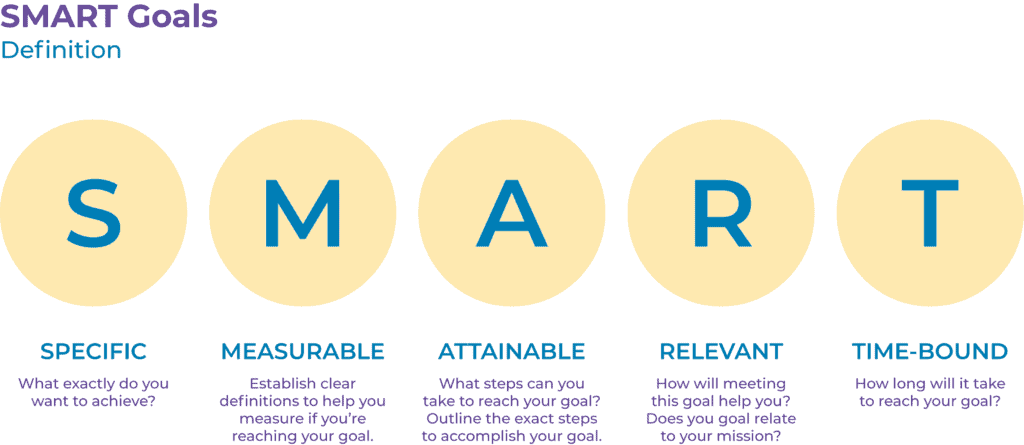7. SMART Goals

What are your campaign goals? How will you formulate them? What actions do you need to take to achieve your goals?
This unit will introduce you to the SMART way of setting goals: a method that can help you clarify your ideas, focus your efforts and use your time and resources productively. It will encourage you to think about your objectives in a specific and focused way and present you with some helpful examples.
After completing this unit, you should be able to:
- Understand the importance of setting clear and precise goals
- Formulate your campaign goals in a SMART format
- Identify the actions you need to take to achieve your goals
“The trouble with not having a goal is that you can spend your life running up and down the field and never score”. – Bill Copeland, Australian sportsperson
To achieve your big dreams, you need to set many smaller, more precise goals. An easy way to do this is to divide your ambitions into SMART goals. If you work through SMART goals, you will achieve future goals quickly and in a structured way.
What Does SMART Mean?
SMART is an acronym that you can use to guide your goal setting. Its origins lie in business administration and management and date back to the 1980s. There are several interpretations of what the letters each mean, which can be useful to give a broader understanding. But for clarity we use the following definition:
- Specific (simple, sensible, significant).
- Measurable (meaningful, motivating).
- Achievable (agreed, attainable).
- Relevant (reasonable, realistic and resourced, results-based).
- Time bound (time-based, time limited, time/cost limited, timely, time-sensitive).

How to Use the SMART Method
1. Specific
Your goal should be clear and specific, otherwise you won’t be able to focus your efforts or feel truly motivated to achieve it.
A specific goal should address questions such as:
- What do I want to accomplish?
- Why is this goal important?
- Who is involved?
- Where is it located?
- Which resources or limits are involved?
2. Measurable
It’s important to have measurable goals, so that you can track your progress and stay motivated. Assessing progress helps you to stay focused, meet your deadlines, and feel the excitement of getting closer to achieving your goal.
A measurable goal should address questions such as:
- How much?
- How many?
- How will I know when it is accomplished?
3. Achievable
Your goal also needs to be realistic and attainable to be successful. In other words, it should stretch your abilities but still remain possible. When you set an achievable goal, you may be able to identify previously overlooked opportunities or resources that can bring you closer to it.
An achievable goal will usually answer questions such as:
- How can I accomplish this goal?
- How realistic is the goal, based on other constraints, such as financial factors?
4. Relevant
This step is about ensuring that your goal matters to you, and that it also aligns with other relevant goals. We all need support and assistance in achieving our goals, but it’s important to retain control over them. So, make sure that your plans drive the campaign forward.
A relevant goal can answer “yes” to these questions:
- Does this seem worthwhile?
- Is this the right time?
- Does this match our other efforts/needs?
- Am I the right person to reach this goal?
- Is it applicable in the current socio-economic environment?
5. Time-bound
Every goal needs a target date, so that you have a deadline to focus on and something to work toward. This part of the SMART goal criteria helps to prevent everyday tasks from taking priority over your longer-term goals.
A time-bound goal will usually answer these questions:
- When?
- What can I do six months from now?
- What can I do six weeks from now?
- What can I do today?
| Example: My aim is to persuade some 12-15-year-old boys who smoke, because they believe that girls think it is sexy and cool, and they therefore feel desired to believe that smoking makes them unattractive to girls who see them as dirty, weak and therefore feel ashamed. To achieve this, we are going to make a video with a creative agency featuring young girls who show that smoking is dirty. This video will be shared on YouTube and will show a phone number people can call to find help to combat their addiction. The video should have at least 2000 views, and we want at least 20 phone calls, within 6 months. |
The Goal is described in a SMART way, because it is:
- Specific: The success is specifically defined with 2000 views, and 20 phone calls.
- Measurable: You can measure the amount of views and calls easily.
- Attainable: We’re working with a creative company who’s going to produce the video, the YouTube channel and phone number are ready to go.
- Relevant: The young girls in the video will be relevant for our 12-15-year-old target audience, the phone calls will help them quit smoking.
- Time-Bound: It will be achieved within 6 months.
Actions
Actions are even smaller than SMART goals. They describe the steps you need to take to achieve a goal. This will help you to define everything you need to do to achieve your goals.
| Example: We are going to make a video with a creative company featuring young girls who show that smoking is dirty. This video will be shared on YouTube and will show a phone number people can call to find help to combat their addiction. |
Some of the actions we need to take are:
- Find a creative agency to make the video
- Write a script with the creative agency
- Recruit the young girls for the video
- Edit the video to make it suitable for YouTube
- Set up a YouTube channel
- Set up the phone number
- Moderate the YouTube video
- Staff the phone line
- Write down the amount of phone calls
- Count the amount of views after 6 months

